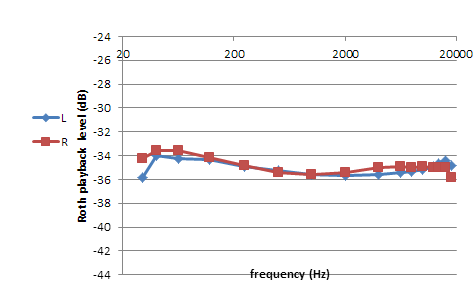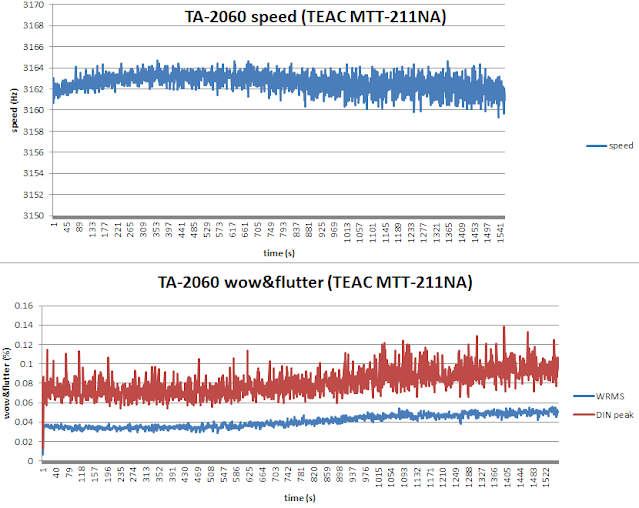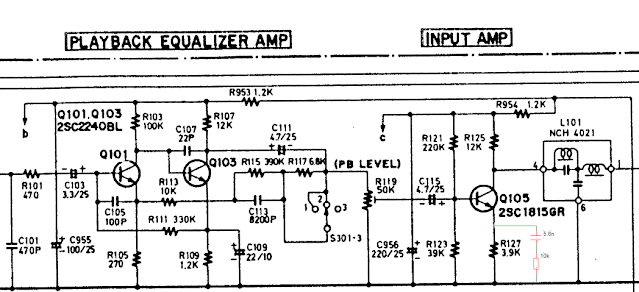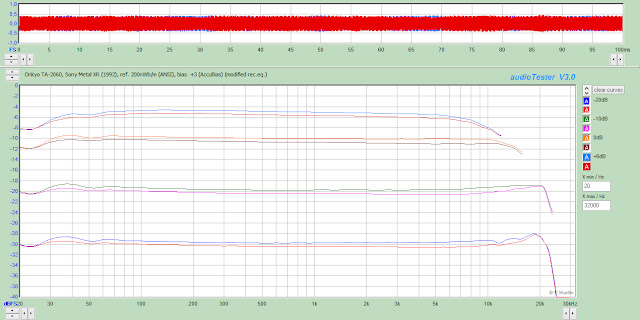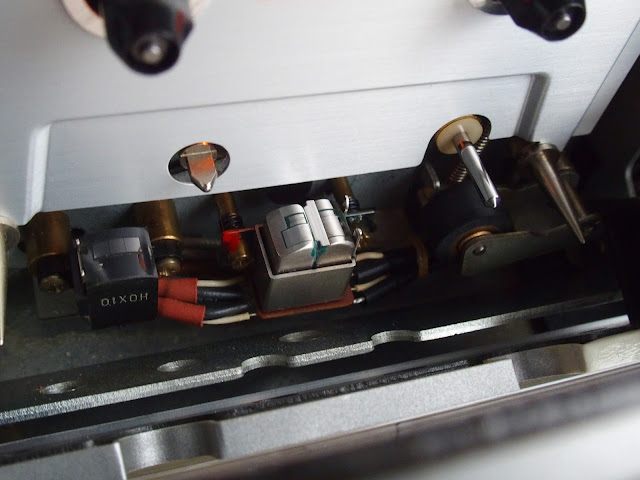This is the story of yet another cassette deck with the Sankyo single-capstan direct-drive mechanism. This transport was also used in the likes of the Kenwood KX-880 series and the Rotel RD-870. It probably pioneered in this Onkyo TA-2055 though.
I was always interested in finding a TA-2055: not only for its historical value, but also because it echoes the aesthetics of the huge TA-2070, the very first mega-deck I encountered as a kid. (In a glossy leaflet, not in real life. Last year I could buy a serviced TA-2070 cheaply, but I let it pass, knowing that this is a Deck From Hell to maintain.)
My TA-2055 was cheap, came from Germany, and must have gone through hell itself because a simple impact to the shipping box had unsettled the record volume knob, the underlying metal frame bent beyond easy repair. In the end I managed to straighten out the volume pot by glueing layers of metal pieces to the bent frame, providing a flat substrate for the potmeter to get screwed onto.
Being a first-generation Sankyo mechanism it obviously used a rubber idle tyre for driving the reel hubs. The provided idler slipped, of course, so it was replaced first with a commercial one, then with a sanded O-ring. Both were not very good and kept slipping (note that a similar O-ring gives fine performance in my TA-2060). The pinch roller was replaced with a new one from https://fixyouraudio.com/.
Another problem was that friction made the cassette shell climb up on the take-up hub, to crash down when the friction on the idler no longer could balance gravity. This gave big transients in speed, as well as a tell-tale knocking sound. The culprit was found to be inadequate cassette clamping, courtesy of a narrow, flimsy clamp in the mechanism's top. The problem was solved by transplanting the wider, sturdier clamp from a Nak CR-2. This required cutting away some metal from the beauty plate.
After this there was still occasional slippage between plastic motor pulley and tyre. Here too a Nak reel drive was substituted, this time a leftover from the BX-125 I restored to great effect in 2018. This improved things somewhat, thanks to its brass pulley. But the idler remained troublesome, even with an ESLabs tyre one (allegedly the best, I hold these in store for my BX-300, when it needs it): after mere days it would start slipping again on the reel hubs. And it was impossible to transplant a gear drive because of the optical encoder patterns on the backs of both hubs. At any rate, such a transplant would be at the cost of the one still nice CR-1 kept here for spares.
Then serendipity struck. While shopping on AliExpress for heads I stumbled over these idler wheels with tyres. (No, I don't like AliExpress: I find it perverse to purchase low-value goods and ship them around the globe, only this time I needed them.) Cheap as they were I bought two and put one in my BX-100, a totally exhausted parts machine, used as a slow winder. It was then left alone for days, normally enough to make its O-ring idler go hard and slip. Not this time, when I returned to it I found a still strong winding torque, in both directions. The secret is in the Chinese tyre's surface, which is pretty rough and spongy. In the long run such tyres may wear faster, but right now they are solving a major problem here. I purchased 12 more of them. (Edit September 2023: even these tyres were no long-term solution. In the end I transplanted a gear drive from a Nakamichi to the Onkyo.)
Another battle had to be fought on the wow&flutter front. Initially it was OKish, but after servicing the mechanism it got jumpy (the tyre stick-slipping, see above), and rising towards the end of the tape. Ultimately I was confronting figures like 0.12% WRMS, with a sharp drop-off in speed through time. Playing with the pinch roller pressure it was clear that at least some of the problem, the major speed loss, could be solved with increasing pressure. This was done by attaching the roller spring to a different point on the roller assembly. The contributions of all of the aforementioned measures got wow&flutter down to a reasonable 0.057% WRMS average, climbing to 0.09% at the end of the tape. It is my theory that rising W&F and dropping speed are now caused mainly by a sticky back tension leaf spring, even though this was lubricated. The Onkyo's reel hubs being not compatible with CR-series hubs I could not transplant the latter's superior back tension coil springs.
Originally playback of the Hanspeter Roth 30Hz-18kHz response tape gave a declining frequency curve, as happens so often with decks of the early 80s. Moreover, the right channel dropped quicker, already 3dB behind the left channel at 10kHz. Seemingly incurable this imbalance suggested head wear, although microscope inspection merely hinted at a copper-coloured discontinuity near the right core. (Then again, my USB microscope is not exactly ideal for head inspection.)
The permalloy head was replaced with a Sankyo Seiki 15RAA4 (of batch T2725), the same head used in the Nakamichi DR-8 and Tascam 112MkII models. While rather soft, it is unique in offering a narrow gap that affords a playback extension to beyond 20kHz, bettering the original head. And above all: 15RAA4s are still available and cheap. (A word of warning: head cable dressing is very important with this deck. With the cable routed just-not-right the head bridge would not come down completely after record or play!)
Being permalloy too no major incompatibilities were to be expected. Once more playback of the Roth tape exhibited the trusted treble rolloff, and only a slight 0.5dB imbalance at 10kHz. (Yes, it should have been zero, but with 40 year old decks theory and practice seldomly go hand in hand.) This treble loss was addressed with a change of time constant in the replay amplifier, plus an additional shelf around 20kHz. Together these flattened the response.
Looking at the recording side bias could be tuned for a reasonably flat response, with Maxell UR 1994 extending beyond 20kHz, but with a 2dB plateau above 3kHz. This was of course expected, given that the replay frequency response had been modified. Consequently the record amplifier was adapted with a down-shelf at its input, plus a capacitor for boosting the high treble (see diagram). After this UR gave a well-extended and reasonably flat response. At the same time the signal attenuators in front of the record amplifier were modified, thereby tuning the deck's record level properly for each of my three chosen tapes (not in the diagram).
SXII 1991 gave a similar result, but with still too much treble peaking and low MOL, calling for a higher bias. Common with many non-Nakamichis this deck only has one set of internal bias trimmers serving the three tape types together. Type switching itself is done with changing the supply voltage to the bias oscillator. This meant that increasing type II bias without affecting the other types could only be obtained by adding a resistor in parallel to the oscillator supply's path, boosting the supply voltage (also not shown in the diagram). This took laborious trial and error, each time connecting/disconnecting the mechanism and flipping the deck upside down. The result was a nice curve, extending to 19kHz.
Early tests with metal (type IV) gave a lot of treble peaking in Left, but drooping in Right. Tracing a 10kHz signal through the record amplifier revealed lacking level and instable signal in the right channel at the output of the opamp. This was quickly found to originate in a bad contact in the front metal type switch. Operating it a few hundreds of times solved the issue (these switches seemed near-impossible to open for cleaning, hence). Once fixed metal bias was also increased by raising the supply voltage. This time optimal flatness could not be reached, indicative of an underbiased condition with respect to the fixed recording equalisation.
Here are the rec/play responses for type IV, II, and I, taken at -20dB, -10dB, and 0dB. As usual when working on two-headers I start the plot at 200Hz: AudioTester does not like replay-time synchronising to signals at lower frequencies, so I tend to omit these. (The curve below 200Hz with MRX-Pro is to be ignored.) I also limited the sweeps to 20kHz at the top. As you can see, the -3dB points at -20dB for types I and II are 18kHz and 20kHz respectively, handsomely beating the deck's original specification of 15kHz and 17kHz!
With these bias levels the Maximum Output Levels (MOL, 3% THD) for Maxell UR, Maxell SXII (or UDII) and That's MRX-Pro were respectively +4.2dB, +2.5dB, and +2.7dB, relative to Dolby flux.
The TA-2055 now mechanically in decent health, and electrically showing that a neutral response with adequate dynamic range was possible it was time to safeguard the machine. Power supply capacitors were replaced with Panasonic FC and FR, and the signal path was dressed up with Nichicon Muse bipolars and Elna Silmics. Two 150nF polarised elcaps in the record amp were replaced with film caps. Where originally this deck sounded OK, but with a rather spotlit high midrange, now it had smoothed out a fair bit, sounding much more homogeneous and really not bad at all on UR and SXII. Metal remained a bit rough, but who in this age is going to use metal tape with such a deck anyway? (I find that metal should remain the domain of those decks that can really drive them hard, up to +10dB!)


























